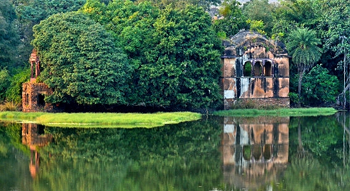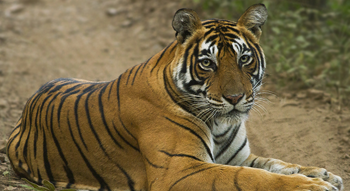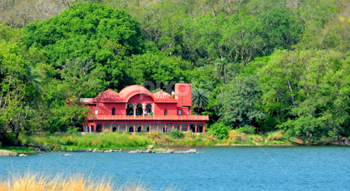- Private car and driver in Delhi / India
- +91-8447445445
- info@discoverindiabycar.com sugar.ankit@yahoo.com
 +91-9818434712
+91-9818434712
Ranthambore
The park has an approximate area of 400 square kilometres, and when coupled with the Sawai Man Singh Sanctuary region, it is around 500 square kilometres. Because of the colourful ruins that are scattered across the national park, Ranthambore is also regarded as a famous heritage site. Visiting Ranthambore National Park is undoubtedly a treat for everyone who enjoys wildlife and the outdoors. The time spent observing roaming tigers, lush vegetation, and a variety of different types of chirpy birds and animals is precious and worthwhile enough to be experienced at least once in a lifetime.
Climate
The Ranthambore National Park region experiences a subtropical dry climate with three distinct seasons that last mostly from summer through to winter and monsoon. The summer season begins in April and lasts until the beginning of the monsoon season in July.
Location
The forest is blessed with incredible natural bliss in the dry and desolate region of Rajasthan state and is located on the plateau that falls between the peaks of the Aravali and Vindhya Range.
History of Ranthambore
Ranthambore, one of the top national parks in Northern India, is well-known for its tigers and is the only location in the country where these majestic carnivores may be seen in the jungle even during the day. There are a lot of tigers in the park. The leopard, nilgai, dhole, wild boar, sambar, hyena, sloth bear, and chital are among the other wild creatures that can be seen in the park. Additionally, there are a wide variety of flora, trees, reptiles, and birds in Ranthambore.
How to Travel Ranthambore?
You can travel Ranthambore by private car and driver from Delhi. Discover India By car provide best tour packages for Ranthambore. Some of the best tour package for Ranthambore by private car and driver are Royal Rajasthan Package, Golden Triangle with Ranthambore and Heart of India Package by discover India by car.
Places to Visit in Ranthambore

Valley of Kachida
The valley, which lies near to the park’s suburbs and is made up of several rocky outcrops and low hills, may be found there. To get about this area, a jeep would be the best type of vehicle. The majority of the park’s Panthers are found in the valley. The tigers are known to kill panthers, so they stay away from the main jungle where they might encounter them. A respectable number of beers live in this region as well.
Bakaula
The densely forested areas of Ranthambore National Park are known as Bakaula Bakaula. It comprises of a deep forest with numerous little water holes and pools located in vegetation clearings. The Bakaula area of National Park Ranthambore contains a lot of wildlife because of the extensive forest cover and accessibility to water. Since the dense forest offers a tigress and her young ones cool hiding places, tigresses with young cubs are frequently spotted beside the water holes in Bakaula.
The location is cooler because to the lush foliage, which also holds onto moisture in the air. One of the coolest areas of National Park Ranthambore is called Bakaula, where little creatures like squirrels and monkeys scurry through the forest and numerous birds can be spotted in the trees.


Lakarda Anantpura
The northwestern and northern parts of the park are must-see areas if you’re looking for sloth bears. Ant hills, a favourite of the brewers, are common in these locations. The Indian striped Hyenas are hardly ever seen, but their pugmarks are frequently observed here. In the park, they are not particularly numerous.
Fort Ranthambore
On top of a hill, the fort commands a great view of the entire park. As you ascend, the surroundings get more and more beautiful, but nothing compares to the view from the fort itself. When visiting the fort, it is advised to bring along a decent set of binoculars and, if possible, a camera with a very powerful lens.
Eagles, vultures, and other birds are seen at eye level in addition to the swirling Serpent. Along the boundaries of all the water bodies, numerous animals can also be seen. Also worth observing and photographing are the fort’s numerous intriguing architectural and historical landmarks. If you are a first-time park visitor, you absolutely must visit the fort.









